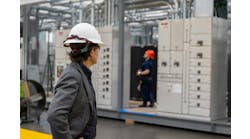Executive Roundtable: Edge Computing Adoption Gaining Traction
After years of high expectations, edge computing is emerging as a more significant component of Internet architecture, with adoption growing across industries, use cases and geographies, according to our panel of data center experts.
The progress of edge computing is just one of the topics we’ll examine this week in the Data Center Frontier Executive Roundtable, which features the insights of five thought leaders on the state of the data center industry. Our First Quarter 2022 roundtable will also explore several other relevant topics: Ensuring uptime as apps and services become more complex, the state of the data center supply chain, and the potential for nuclear power as an option for data center energy sourcing.
Here’s a look at our distinguished panel:
- Brad Alexander, Vice President and CTO, DartPoints.
- Sean Farney, Director, Marketing & Business Development – Data Center at Kohler Power Systems.
- Amber Caramella, the Chief Revenue Officer at Netrality Data Centers, and Advisory Council member at Infrastructure Masons
- Peter Panfil, Vice President of Global Power at Vertiv.
- Michael Goh, Vice President and General Manager for Iron Mountain Data Centers division for Asia.
Each day this week I’ll moderate a Q&A with these executives on one of our key topics. We begin with our panel’s take on the state of edge computing.
Data Center Frontier: How is edge computing evolving, and what use cases and applications are gaining the most traction with customers?
PETER PANFIL, Vertiv
Peter Panfil, Vertiv: Edge computing is an extremely versatile strategy that can be used to support a range of applications, depending on where it is deployed. Vertiv has identified four edge computing models – from the device edge to the regional edge – and the applications being supported by these models, or a combination of them, can be very different.
We recently surveyed the market and found that the most popular applications being supported by micro edge sites, which we define as deployments of less than four racks, were predictive and condition-based maintenance, supply chain management, and real-time inventory management. In larger regional edge deployments, we are seeing growth in high-performance computing applications with rack densities for some sites pushing 50 kW. Where there used to be high-density pockets of IT spread around in data centers, they are now getting concentrated in liquid-cooled containers at the edge.
So, the edge is evolving in multiple ways with one common denominator – growth in both the amount of compute, and the percentage of an organization’s compute, deployed at the edge.
“The edge is evolving in multiple ways with one common denominator – growth in both the amount of compute, and the percentage of an organization’s compute, deployed at the edge.”
Peter Panfil. Vertiv
BRAD ALEXANDER,
DartPoints
Brad Alexander, DartPoints: Edge computing is really starting to become about the supporting features and functions of whichever platform people are using. Bare metal at the edge has been and will continue to be popular, but edge computing platforms that can make networking, PaaS, or containerization more scalable and easier to use are growing in popularity. Content providers are pushing to make compute at the edge easier to consume, and billions of dollars are being put into smaller tier two and tier three markets. These are the markets where DartPoints deploys digital infrastructure and cloud.
Something that has really gained traction with our customers is data thinning, which is where data is processed at the edge and then sent back to a centralized storage repository. Artificial intelligence (AI) at the edge is also booming right now. One of the fastest-growing use cases we’re seeing is in the retail industry. Companies are using AI to intelligently process data and consumer interaction in real time to identify target audiences, and build focused advertising campaigns in real-time, and at scale.
AI and IoT have transformed the retail industry for businesses by providing intelligent, real-time analytics on specifics such as customer preferences, inventory requirements and pricing trends. In addition, these advancements improve the customer experience by ensuring stores have the items they want, when they want them, at the price they want to pay. AI really is a game changer in the retail space.
“AI and IoT have transformed the retail industry for businesses by providing intelligent, real-time analytics … AI really is a game changer in the retail space.”
Brad Alexander, DartPoints
SEAN FARNEY, Kohler Power Systems
Sean Farney, Kohler Power Systems: Ten years ago, the edge data centers I was building with Schneider Electric were 100-300kW modular facilities in Tier 3 MSAs, for use almost exclusively by MSOs, telcos, and other wireline content providers; little more than outpost IDFs. Today’s edge data center has a much more nebulous Basis of Design: multi-megawatt in size, fully redundant power lineups, popping up in core Tier 1 cities to serve both wireline and wireless traffic.
I credit the prevalence of high-bandwidth connectivity, be it ubiquitous WiFi or 5G wireless, with this changing definition of edge. Staggering growth in the number of connected devices and always-on access has exponentially accelerated the creation of content and, consequently, the need to replicate and distribute it. With the growth in data also comes a growing reliance on and expectation for guaranteed access to this data. Therefore, edge facilities have taken on more elements of traditional uptime-driven design.
With the addition of true mission critical applications and services like medical wearables and autonomous vehicles, we will see continued emphasis on infrastructure resilience and continued re-definition of what “the edge” really means. This is why providers must be very attuned to industry trends and have broad product lines to address ephemeral needs. Kohler’s long-standing relationships with both telecom and data center clients help to keep us on the leading Edge of industry needs.
AMBER CARAMELLA,
Infrastructure Masons and Netrality
Amber Caramella, Netrality and Infrastructure Masons: Edge computing is evolving at a feverish pace. The increase of remote workers, the surge in data, 5G, and the Internet of Things (IoT) play a pivotal role in this evolution.
Gartner predicts by the end of 2022, 31% of workers worldwide will be fully remote or following a hybrid model. The United States will have 53% of its workforce working remotely. This trend has organizations shifting from traditional servers to a hybrid model where they have a combination of cloud computing and colocation for flexibility, security, and a way to enhance their existing cloud infrastructure.
Modern-day innovations are needed to enable a digitally connected world relying on 5G wireless connectivity. The IoT market is growing exponentially, with connected devices predicted to reach 31 billion by year’s end. The Internet of Things connects more and more devices, forcing networks to transition from being on a straight one-lane highway where information is going to and from a central location – something that looks like a web where interconnected devices stream to and from many locations, capturing, storing, processing, and analyzing data near the source where the data was generated instead of the central server or data center.
The digital world continues to evolve, and has made great strides across all industries. Edge computing use cases like augmented reality, virtual reality, telemedicine, biotechnology, robotics, and autonomous vehicles require service provisioning closer to users.
Diving deeper into a few of these use cases, biotechnology is one of the most data-intensive industries. Excessive data is required to develop and trial new specimens, new products, cures, and solutions. 5G power is redefining innovation in biotechnology, enabling labs and devices to process and transmit data quickly, utilizing artificial intelligence and machine learning to track and analyze billions of molecular interactions, expedite the development of new advancements, shorten the R&D time for new drugs, and gain a deeper understanding of the relationship between genetics and diseases.
MICHAEL GOH,
Iron Mountain
Michael Goh, Iron Mountain Data Centers: Edge is the fastest-growing segment in the cloud category with the total market expected to expand 37% annually through 2027, according to Grand View Research. Telecom networks, IoT for energy production, video streaming, cloud gaming and retail and public transport apps are all driving demand, along with multi-point next-gen Industry 4.0 apps.
A study by Tomas Rahkonen and Rhonda Ascierto of the Uptime Institute found that the portion of owners/operators using more than 20 Edge data centers today is likely to double in the next two to three years (from 9% now to 20%).
Edge will continue to grow and will be a key segment soon. However, foundational pieces are still being laid out and the trend is moving towards decentralization from key markets to smaller markets. We see players like AWS rolling out Local Zones and Azure moving forward with their Edge deployments. The key dependencies on edge will be connectivity and more coverage.
NEXT: Our panel considers reliability in the age of hybrid infrastructures.
Keep pace with the fact-moving world of data centers and cloud computing by following us on Twitter and Facebook, connecting with DCF on LinkedIn, and signing up for our weekly newspaper using the form below:






